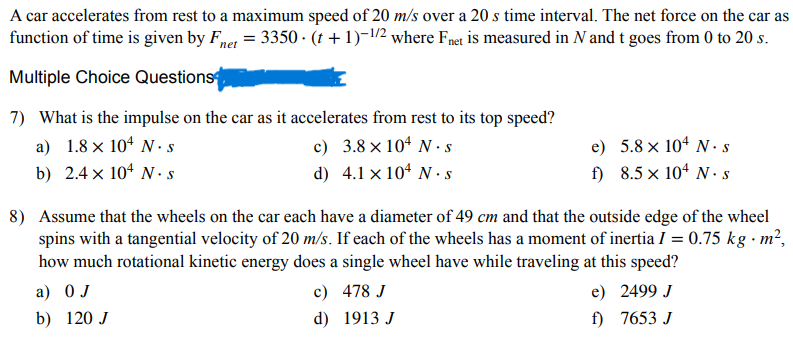A car accelerates from rest to a maximum speed of 20 m/s over a 20 s time interval. The net force on the car as function of time is given by Fnet = 3350 (t + 1)-1/2 where Fnet is measured in N and t goes from 0 to 20 s. Multiple Choice Questions 7) What is the impulse on the car as it accelerates from rest to its top speed? a) 1.8 × 104 N. S b) 2.4 x 104 N.S c) 3.8 × 104 N s d) 4.1 x 104 N s e) 5.8 × 104 N. s f) 8.5 × 104 N. S 8) Assume that the wheels on the car each have a diameter of 49 cm and that the outside edge of the wheel spins with a tangential velocity of 20 m/s. If each of the wheels has a moment of inertia I = 0.75 kg. m², how much rotational kinetic energy does a single wheel have while traveling at this speed? a) O J b) 120 J c) 478 J d) 1913 J e) 2499 J f) 7653 J
A car accelerates from rest to a maximum speed of 20 m/s over a 20 s time interval. The net force on the car as function of time is given by Fnet = 3350 (t + 1)-1/2 where Fnet is measured in N and t goes from 0 to 20 s. Multiple Choice Questions 7) What is the impulse on the car as it accelerates from rest to its top speed? a) 1.8 × 104 N. S b) 2.4 x 104 N.S c) 3.8 × 104 N s d) 4.1 x 104 N s e) 5.8 × 104 N. s f) 8.5 × 104 N. S 8) Assume that the wheels on the car each have a diameter of 49 cm and that the outside edge of the wheel spins with a tangential velocity of 20 m/s. If each of the wheels has a moment of inertia I = 0.75 kg. m², how much rotational kinetic energy does a single wheel have while traveling at this speed? a) O J b) 120 J c) 478 J d) 1913 J e) 2499 J f) 7653 J
Physics for Scientists and Engineers with Modern Physics
10th Edition
ISBN:9781337553292
Author:Raymond A. Serway, John W. Jewett
Publisher:Raymond A. Serway, John W. Jewett
Chapter9: Linear Momentum And Collisions
Section: Chapter Questions
Problem 10P: The magnitude of the net force exerted in the x direction on a 2.50-kg particle varies in time as...
Related questions
Question

Transcribed Image Text:A car accelerates from rest to a maximum speed of 20 m/s over a 20 s time interval. The net force on the car as
function of time is given by Fnet = 3350 (t + 1)-1/2 where Fnet is measured in N and t goes from 0 to 20 s.
Multiple Choice Questions
7) What is the impulse on the car as it accelerates from rest to its top speed?
a) 1.8 × 104 N. S
b) 2.4 x 104 N.S
c)
3.8 × 104 N s
d) 4.1 x 104 N s
e)
5.8 × 104 N. s
f)
8.5 × 104 N. S
8) Assume that the wheels on the car each have a diameter of 49 cm and that the outside edge of the wheel
spins with a tangential velocity of 20 m/s. If each of the wheels has a moment of inertia I = 0.75 kg. m²,
how much rotational kinetic energy does a single wheel have while traveling at this speed?
a) O J
b) 120 J
c)
478 J
d)
1913 J
e)
2499 J
f)
7653 J
Expert Solution
This question has been solved!
Explore an expertly crafted, step-by-step solution for a thorough understanding of key concepts.
This is a popular solution!
Trending now
This is a popular solution!
Step by step
Solved in 1 steps with 1 images

Recommended textbooks for you

Physics for Scientists and Engineers with Modern …
Physics
ISBN:
9781337553292
Author:
Raymond A. Serway, John W. Jewett
Publisher:
Cengage Learning

College Physics
Physics
ISBN:
9781285737027
Author:
Raymond A. Serway, Chris Vuille
Publisher:
Cengage Learning

College Physics
Physics
ISBN:
9781305952300
Author:
Raymond A. Serway, Chris Vuille
Publisher:
Cengage Learning

Physics for Scientists and Engineers with Modern …
Physics
ISBN:
9781337553292
Author:
Raymond A. Serway, John W. Jewett
Publisher:
Cengage Learning

College Physics
Physics
ISBN:
9781285737027
Author:
Raymond A. Serway, Chris Vuille
Publisher:
Cengage Learning

College Physics
Physics
ISBN:
9781305952300
Author:
Raymond A. Serway, Chris Vuille
Publisher:
Cengage Learning

Glencoe Physics: Principles and Problems, Student…
Physics
ISBN:
9780078807213
Author:
Paul W. Zitzewitz
Publisher:
Glencoe/McGraw-Hill

College Physics
Physics
ISBN:
9781938168000
Author:
Paul Peter Urone, Roger Hinrichs
Publisher:
OpenStax College

University Physics Volume 1
Physics
ISBN:
9781938168277
Author:
William Moebs, Samuel J. Ling, Jeff Sanny
Publisher:
OpenStax - Rice University